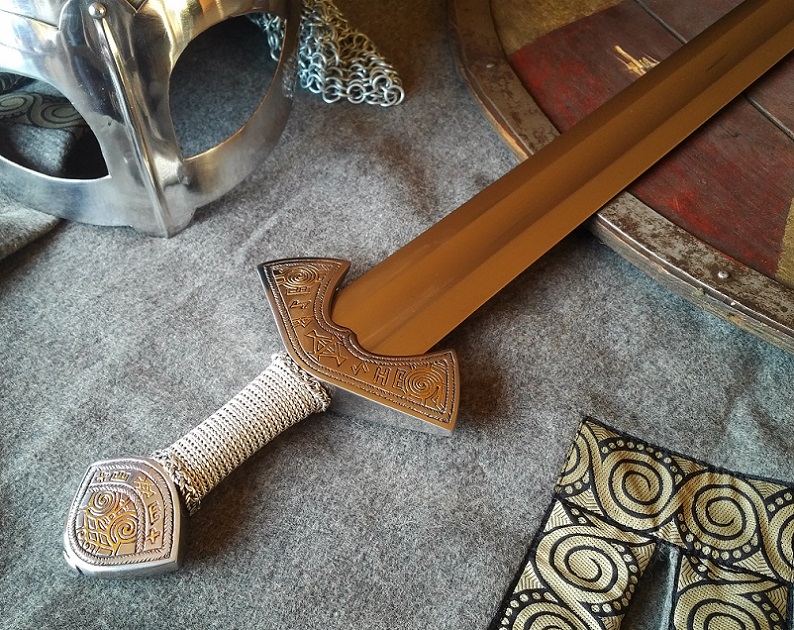As many of you know, a beautiful and well preserved late Viking-age sword was excavated from a gravesite in the village of Langeid (Norway) in 2011, and is now on display at the Museum of Cultural History at the University of Oslo. The 37” sword is of Petersen’s type AE, a somewhat uncommon type with curving, wide flaring ‘quillons’ and often a D-shaped pommel (the most famous example being the similar Suontaka sword from a woman’s gravesite in Finland). The beautifully preserved silver and gold decorations on the hilt and surrounding evidence of an enclosure suggest the owner was a high-status individual. Further evidence (an English coin at the site, a nearby commemorative stone) suggest that this individual may have accompanied King Knut (Canute) on his wars of conquest against King Æthelred II (the unready). It’s noteworthy that this site shows signs of both pagan and Christian influences, for example the burial style vs. the Christian motifs on the sword hilt, and the wording of the nearby stone. Overall, all signs point toward dating the sword toward the first half of the 11th century.
Rob Miller of Castle Keep, located on the Isle of Skye Scotland, has been a swordsmith for over 25 years. Mr. Miller employs traditional forging techniques and is known for a range of products including Viking, Medieval, and Renaissance Scottish weapons, both production and custom. Recently he decided to include an interpretation of the Langeid sword, as shown on his web-site. According to Mr. Miller, the version that has come into my possession is the original prototype for this sword. As a prototype, the version I own is slightly different from both the original sword, and Castle Keep’s current version, as I will explain below. The prototype, however, will be reviewed on its own merits.
Vital Statistics
Blade type: a wide fullered XII (or short fullered Xa with pronounced profile taper).
Hilt type: Petersen’s AE
Overall Length: 36 7/8”
Blade Length (from deepest point): 31 5/8”
Blade width at cross: 1 15/16”
Distal Taper: Non-linear – 4.5mm at cross, 4mm at end of fuller, narrowing rapidly to 1mm near tip.
Profile taper: Also non-linear, with a smoothly accelerating curve toward narrow tip.
Fuller Length: 21 ½”
Grip Length (at greatest extent): only 2 ¾” (!!!)
Centre of Gravity (from ‘ecusson’): 6.5”
Distal Harmonic Node (Optimal Striking Point): ~ 11.5” from tip.
Proximal Harmonic Node: at junction of blade and cross.
Distal Pivot Point: ~4.5” from tip.
Weight: 2 lb. 9.5 Oz.
Historical Accuracy
Rob Miller calls this an interpretation, not a reproduction or replica. Nevertheless, so far as I can tell, the hilt is very accurate with one exception. The shape of the cross and pommel, the braded silver wire and ‘Turk's head’ finials on the grip, and gold-over silver plating all look correct. The strangely short grip is historically accurate (I found the measurements in an on-line article that noted this is the shortest example so far of a type that is already usually quite short). The exception is that whereas Mr. Miller has reproduced one side of the decorative design very faithfully based on the picture he had at the time, he had to guess at the same design on the other side. In fact, the two sides of the original are slightly different ( see below). The other departure is in the blade. The original appears to be a typical Xa ‘chopper’ of the period, with longer fuller and spatulate tip, whereas this version has a shorter fuller and much more profile taper to a stabbing point. It appears to be borrowed from his version of the Suontaka sword, but with a narrower fuller. Otherwise, the overall dimensions appear to be similar.
Handling Characteristics (or, ‘How to hold a short-gripped AE Viking sword’)
Here’s where the fun begins. This sword, like the original, has a pretty average sized medieval blade, but a very short grip, even by Viking standards (see comparison with my Jeff Helmes ‘Korsoygaden’ sword below). It took some time to 'get a handle' on this odd beasty. I expected the ‘hammer’ grip would not work and that proved to be the case. This grip style makes a tight squeeze and causes the corner of the pommel to dig into the palm when the sword is in motion (see first of 3 grip positions pictured below). As expected, the ‘handshake’ grip was more comfortable, but this places the pommel in the palm (see second picture). This position gave terrific reach, but my wrist soon tired because one is basically swinging the sword by the pommel with very little support. That's when I got a bit concerned about my purchase.
However, after a while I tried something new to me: only putting the little, ring, and middle finger on the grip, which forces the thumb and forefinger up against the broad, flat cross, something like holding a rifle (see third picture). The first thing I noticed with this odd grip was that gripping the cross like this gave tremendous ‘indexing’ control of the edge and tip, while also allowing the pommel to leverage against the hand in a comfortable way. Once I stopped this analyzing, and just started swinging the sword around with a relaxed grip, I found myself settling comfortably into the third position, being able to transition between 3-fingered versions of the hammer and handshake grip as required, while maintaining a precision grip hold on the cross. In this position the forefinger looks and feels a bit exposed, but aligns with the cross shape and still has more protection than looping the finger over the cross as often seen in medieval art. Was this the way the original sword was intended to be used? Who knows, but it feels right.
Once I adopted this style, the sword handled as well as one can expect from a sword of this era, although I’d still prefer a slightly bigger handle (my wife wondered if this grip was designed for a woman, like the Suontaka sword). By the way, I don’t like the feel of a wire grip, especially the finials on this one, so I used a glove to handle this sword. Two other things of note: as the above stats might suggest, this sword is better at thrusting than one usually expects from a Viking sword, but for some reason it’s hard to swing from right to left (using the right hand) in the usual knuckles-down manner. This is remedied by keeping the knuckles up and using the weak edge in that direction. With these adjustments, the sword was reasonably comfortable, moved quickly through cuts, and transitioned into and out of guard positions as well as one can expect from a Viking sword. Finally, the sword is sharp, although not razor sharp. A tiny secondary bevel is just visible, similar to what A&A usually uses. I would expect it to cut as well as the average medieval arming sword.
Fit and Finish
This is a pretty sword. Even my wife said so. And by ‘pretty’ I don’t mean anything demeaning, but in the best way possible: the entire design of the blade flows with the shape of the cross and pommel, and is highlighted by the intricate and tasteful décor on their surface. Also, the width and proportions of the cross and blade –very important for this type to look good – are just right. The blade demonstrates the expertise of a mature, master craftsman. The profile is as perfectly executed as a CNC-milled blade, and the fuller nearly so. The tip portion has a perfect lenticular cross-section, and the surface has a nice satin sheen. My piece was made fairly recently but has already passed through a few hands (I bought it through myArmoury Marketplace, and traced it back to another sale on SBG), so this may account for a few superficial scuff marks. Otherwise it’s in great condition.
There are some imperfections in the hilt fittings that could relate to this being the prototype. It’s all tight and solid and the peen is clean, but the cross is slightly rotated in the plane of the blade and the pommel is a bit tilted in the perpendicular plane. These deviations are within the limits of hand-made weapons that I have owned in the past. This though is overshadowed by the beauty of the décor (which I guess is probably done using silver and gold plating over cast bronze) and evenly woven wire grip. Thanks to the original cutler and Mr. Miller’s excellent modern execution, this is one cool design. There are a few pock-marks on the surface, but considering that even Albion sometimes has casting pits on its pommels, I won’t take away any points.
Updated Version
Based on inspection of the Castle Keep web-site and a brief e-mail exchange with Rob Miller, it appears that the current version of this sword has changed in a few ways from the prototype, some ways historical and some purely esthetic. It now has both side of the hilt decoration done correctly. The Turks-head finials are replaced by what looks like silver collars that are less historical, but look better and are probably more comfortable. There is now some cool gold inlay on the upper blade in the style of the hilt, although I’m not aware that has been shown on the original sword. Finally, the fuller seems wider, which would likely lighten the sword but take it in a direction further away from the original. Not having handled the current version myself, I cannot say if the dimensions are otherwise the same or if it feels any different.
Conclusion
This sword demonstrates an impressive amount of skill and workmanship in both the fundamentals of bladesmithing and in the additional artistry of the hilt. A new model is pricey, but if Mr. Miller has managed to work out some of the minor bugs mentioned above, I would say it’s well worth the money.
On a more personal note, I’m generally a guy that likes simple, austere medieval swords. This is the first time I have invested in a higher-end production/custom sword with so much decoration on the hilt. There was just something ‘right’ about this one that attracted me and got me more excited than I have been for a while to acquire a sword. Handling was initially a bit of a struggle, but seems to have worked out. Time will tell if this one grows on me even more and starts a new direction in my collecting.
Yours truly, JD Crawford

Original Sword
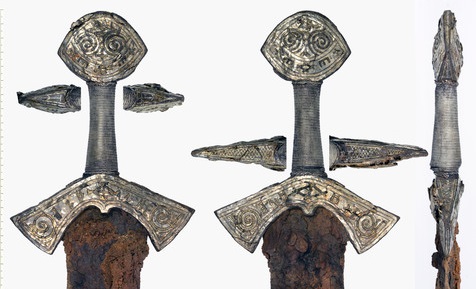
Decorations on Both Sides

Full length view of modern sword
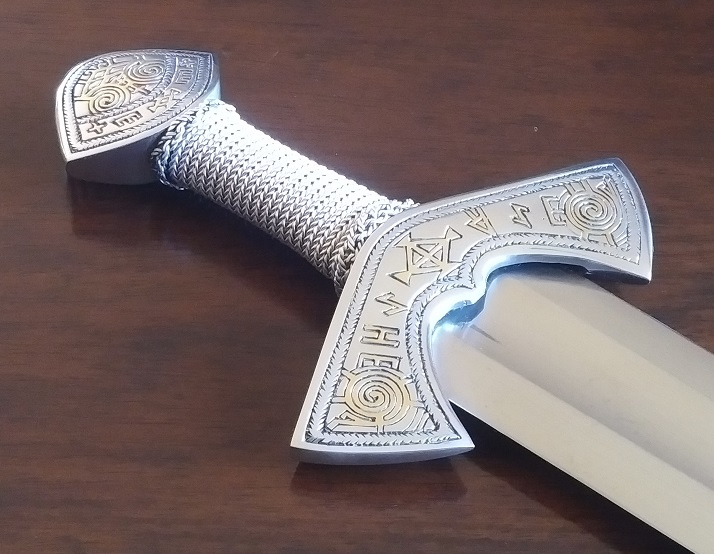
Cross view of hilt

Pommel view of hilt
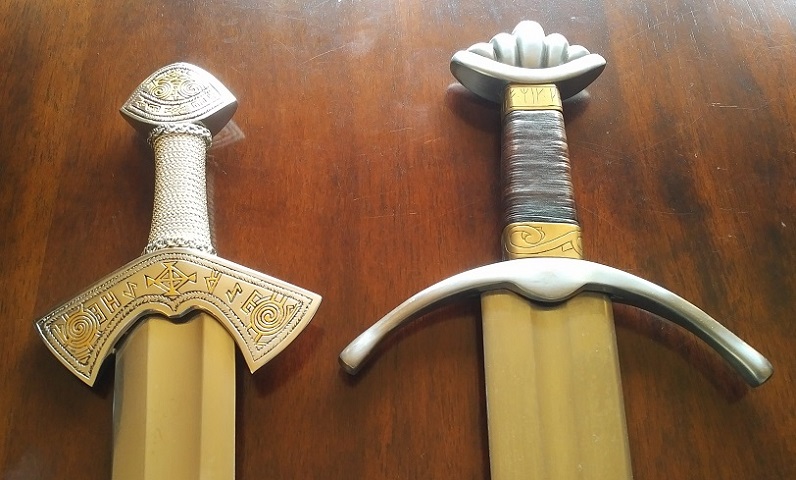
Comparison to Korsoygaden

Three grip styles: hammer, handshake, 3-finger gun grip.
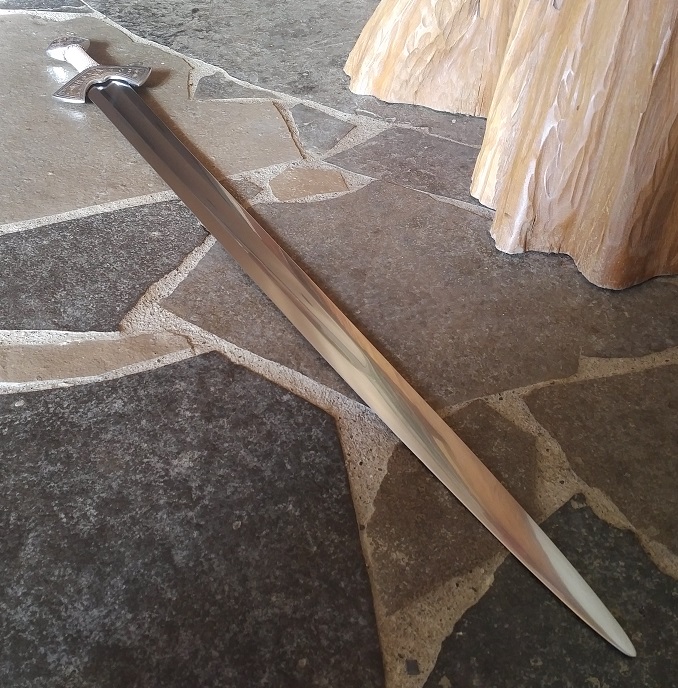
Blade view
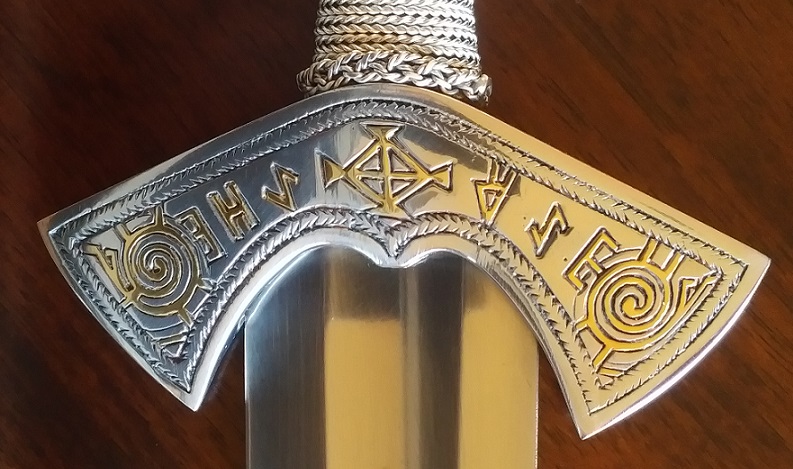
Cross detail
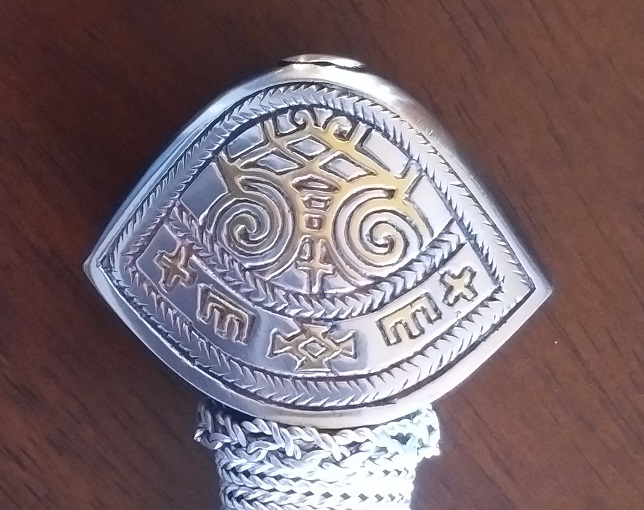
Pommel detail
